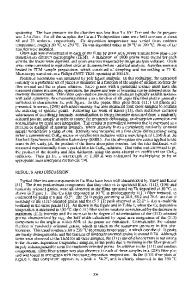Effects of Ta on the Microstructure and Magnetic Properties of FePt Thin Films
- PDF / 240,364 Bytes
- 5 Pages / 612 x 792 pts (letter) Page_size
- 19 Downloads / 335 Views
0998-J05-12
Effects of Ta on the Microstructure and Magnetic Properties of FePt Thin Films Sangho Jin, Sung Uk Jang, and Soon-Ju Kwon Materials Science and Engineering, POSTECH, Hyoja-Dong, Nam-Gu, Pohang, 790-784, Korea, Republic of ABSTRACT We have studied the effect of Ta on the structure, magnetic properties and the ordering temperature of FePt(Ta) thin films. The samples are prepared by the dc and rf magnetron cosputtering method with 3 single element targets. After a deposition, the samples are annealed in a vacuum at various temperatures. The XRD patterns show strong (111) peaks at all annealing temperatures, but the change in the d-spacings reveals a disorder-order transformation. The more Ta is added to the FePt, the larger the coercivity becomes. The coercivity of the FePtTa40W film annealed at 700oC reaches about two times as large as the value of the pure FePt film. The delta m curves imply that Ta atoms diffuse into the grain boundary to reduce inter-granular exchange coupling, which leads the enhancement of coercivity. INTRODUCTION The popularity of computer internet and mobile digital recording devices has resulted in a increased demand for higher recording density for data storage. The increase in recording density requires the dramatic reduction of the volume of each bit cell. This naturally raises the concerns related to the thermal instability of recording media because the phenomenon incurs the loss of stored data. The product of the anisotropy energy (Ku) and the volume of the magnetic switching unit (V) represent the energy barrier to the magnetization reversal in the presence of thermal fluctuations. L10 FePt is known to have anisotropy energy (Ku) 15 times larger than the current hcp Co magnetic recording material [1]. It is this large magneto-crystalline anisotropy that has drawn considerable attention to the L10 FePt thin films as a potential high density magnetic recording material. But as-deposited FePt thin film has a soft magnetic disordered face centered cubic (fcc) structure as a major phase and possesses low coercivity. In order to form a hard magnetic ordered L10 phase, the as-deposited film needs to be ex-situ annealed at a temperature of 600oC or higher [2]. The high annealing temperature may cause the deformation or damage of the substrate and result in large surface roughness and grain growth. Thus, it is important to develop methods through which the ordered L10 phase in FePt films forms at a relatively low temperature. Also high coercivity, a small grain size, and inter-granular decoupling are required for the high performance of recording media. To do this, several attempts have been made to fabricate L10 FePt films by molecular beam epitaxy (MBE) [3] and multilayer film sputtering [4]. However, both methods require the rigorous control of the film process. The development of a sputtering process for a single layered L10 ordered FePt film may be more desirable for industrial application [5]. Additional agents are needed to tailor the thin film microstructure and magnetic pro
Data Loading...











